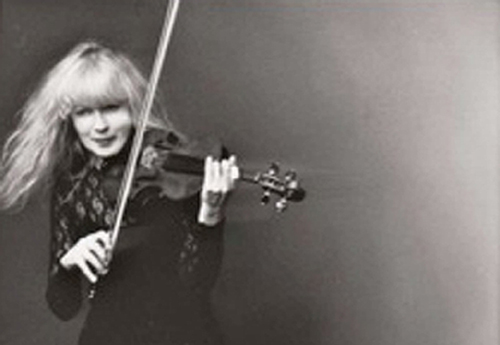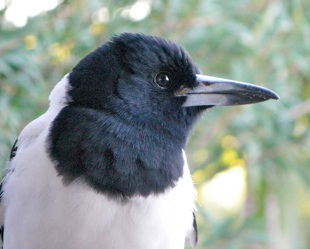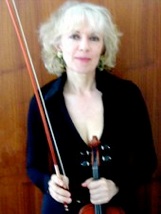Music and Landscape: Hollis Taylor is a violinist/composer who has become an expert on the vocalisations of the Australian Pied Butcherbird, which she incorporates in her music compositions and performances.
Born in America, she now lives and works in Sydney and travels extensively in the outback to record birds.
WHAT PROJECT ARE YOU WORKING ON AT THE MOMENT?
I have just finished writing a book; it’s called Is Birdsong Music: Outback Encounters with an Australian Songbird.
In addition, I am just about to leave to record Lyrebirds up in the New England National Park area. I do that every winter because they sing in that season… so it doesn’t interfere with the other bird I study, the Pied Butcherbird, who I record in the spring. I started listening to Lyrebirds in 2006, but my fieldwork on them began in 2009. I am part of a research group that is mapping the territory of the ‘superb lyrebird’ in and around New England National Park.
There, many of them sound similar to flute players, and nowhere else in the country do we find this. There is a myth that we have been tracing, a story about one growing up in captivity and learning to imitate the flute (see http://www.flutelyrebird.com).
Then in late June, I’ll go to Alice Springs for about three months, followed by Queensland. So, this time of year is always full-on for me.
WHAT IS YOUR PREFERRED EXPOSURE TO THE LANDSCAPE?
Being in the field. Most of my research is ‘extensive’, meaning that I travel every day to a new bird in a new place. But this year I am doing something different in Alice Springs: it will be more ‘intensive’, as I am staying in the same place for a longer period of time.
Either way, it is a lot of work.
AP: How do identify your successive locations? Are these places you have been before? How do you find the birds?
The first year I struggled: I didn’t know what they sounded like for sure (compared to another similar birds), I didn’t know what they looked like for sure, even though I had seen pictures… and I didn’t know really when they would sing.
No one had ever done a peer-reviewed paper on them, so much was unknown.
I read some bird guides and corresponded with ornithologists, and they gave me somewhat of an idea… Now, I have regular places that I visit annually. I like to return to the same places. If I hear of a really good place, I might add that, but basically I am loyal to the same locations.
AP: Is it just you, your car and your recording equipment? Do you also take some pictures?
Yes, I do take pictures, and sometimes I take video, but the main songs that I record are nocturnal songs. These can start as early as eleven or twelve at night and last until dawn, so obviously these birds I never see, or I may have a brief glimpse of them as the sun comes out.
Recording of Pied butcherbird duet:
AP: You are there, sitting outside your car and recording…is it magical or frightful?
Yes, very frightful…. in total darkness.
AP: How was the very first time? This encounter with the land in an environment that must have been quite foreign at the time?
Well, I don’t know that it gets easier. It’s scary. That’s all there is to it.
I have written some things about it in my book: I have encountered wild camels, I know they are not deadly (not unless you are susceptible to heart attack), but when you have three wild camels between you and your car…. or when a pack of dingos are between you and your car and the sun comes out and you see them, just there, a pack of hungry dingos…. I mean, one dingo, no problem, and I love dingos, they are gorgeous animals, but a pack…
Snakes are often a concern out there because they can be active at night. I have also had domestic dogs all of the sudden come and bark at me, I’ve had drunk people come up and stop and honk and shine their light at me in the middle of nowhere…. How did they find me?
It all happens. You’re out there, you have your headphones on and you hear a kangaroo coming towards you, but you don’t know for sure if it’s a kangaroo or a person.
My relationship to the land, or nature, or to the landscape (however we define them) is very different in Australia from what it would be in Oregon (in the US) where I am from and which is a beautiful green place that is in my bones really. I love it.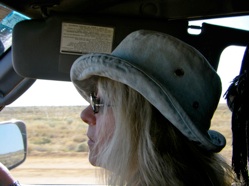
Australia can be much drier, much harder. Dengue fever is in some of the places I go, the trees have figured out how to have very small leaves and turn them away from the sun so you get no shade, you see–so all landscape, all nature, is not interchangeable.
I find Australia to be very demanding, so I don’t romanticise it at all. If people want to romanticise my bird work, they can, but I don’t: I go from one place to the next, I don’t cook, it’s not like I’m cooking wonderful meals–I don’t have time to cook. I have a granola bar for breakfast, a can of tuna for lunch… work during the night….
COULD YOU TAKE ME BACK TO WHERE YOU STARTED? WHERE WERE YOU BORN?
I was born in Portland, Oregon, in suburbia. We lived at the end of a cul-de-sac where there were always places to run, and I did because in those days you could…. It had big trees and creeks… so I was used to camping, but nothing prepared me for camping in Australia–it’s completely different.
AP: You became a musician. How different were your earlier compositions compared to what you are doing now?
My work was completely different. On my first trip to Australia, I traveled to WA for a music festival. We were eight hours north of Perth on a sheep station. I heard three Pied Butcherbirds in a tree singing in a trio. I was astounded that birds sang in ensembles. I had no idea. It was the most beautiful thing–it was an epiphany!
I had spent my whole life as a violinist and a composer, performing in various genres from classical music to Texas fiddle tunes, bluegrass, pop, and jazz. I was not thinking of changing direction, but after hearing these birds I wanted to know more. Unfortunately, there were only a couple of CDs with these birds’ songs on them. So, a couple of years later when my partner and I moved here (he is Australian), I decided to undertake a PhD to illuminate and celebrate their song
Joanne Cannon on bassoon playing Hollis Taylor’s Composition “Cumberdeen Dam – Notturno” (sample)
AP: From a musical or artistic point of view, what did that first encounter with the Butcherbird trigger?
I thought ‘there is something going on there, and I want to try to figure out what it is’. Composers might get their ideas from anywhere. For me in this instance, my methodology wasn’t like Olivier Messiaen, who would hear a bird and write down something with the ultimate purpose of merging it into in a piece.
When I heard what they sang, I wanted to know what they were doing. I really wanted to understand more, whether or not I ever composed with it. I sensed that it was a really sophisticated musical mind at work. And they are all really different: every adult Pied Butcherbird sings differently from the next one, and they change their nocturnal solo songs annually.
I thought, I will map it–I’ll figure out what they are doing, and I’ll map how it slowly changes from neighbour to neighbour, except it doesn’t work like that. The bird next door may sing something totally different, or it may have something in common. But it doesn’t slowly evolve over the land like you might expect.
AP: Are you saying that a particular bird will have a particular songline and stick to it?
It will have say … twelve phrases ……and maybe, a hundred ways of changing each one of these phrases, because the phrases aren’t always so distinct and separated. They are more like ‘snap-together beads’, like modules. These birds are minimalist composers. There are additive and subtractive notes and motives that they string together. So, the bird you can hear in the distance may be singing something completely different… or they can be singing something similar but be putting their own spin on certain sections. And each individuals phrases appear to be dynamic, changing annually.
AP: Can you actually recognise a particular bird by it song because you would have heard it before? Can you identify individuals based on their songs?
Mmm, I think I probably could for the ones I know best. The more complicated their particular song is, the easier it becomes to identify them by it. But I don’t try to make that claim.
AP: So in the first instance your interest was in researching and mapping rather than how that could feed your own creative output?
Exactly. I always thought I would compose based on their vocalisations, but not in the first year or two, because I really wanted to understand what they were doing first. I tried to keep them quite separate to begin with.
I make one transcription that is as accurate as I can make it without overdoing the detail; my goal is to get down what they have sung–to emphasize them and keep myself out of it as much as possible. (Of course, I cannot remove myself entirely, but I think it helps that I have a varied background in music, so I can imagine more than one way to notate and think of a bird’s phrases.) Then, for my own (re-)composition, if I am going to play it on the violin, I will allow myself to modify the transcription. Interestingly, I find that I don’t change them very much except for shortening them (I’m not going to play a three or a six hour song!).
“Cumberdeen Dam – Capriccio” (sample) – Joanne Cannon on bassoon playing Hollis Taylor’s Composition
When I have inserted my own ideas, it’s often failed, and I have to go back to the original recording or transcription–I have to go back to what they’ve done, because they work with the material all year, and they know how it works. So I try not to get too clever.
I think also it’s because I’ve had my career, I’ve had a thirty-year career, I’m at a good age to not care. Whereas if I was twenty or twenty-five, I’d be trying to do the hardest or the most amazing thing possible based on their song. I’m really very happy to just make them famous, if you know what I mean.
AP: Outside a career expectation, does the work you do feed other forms of musical composition for you anymore?
No, I only compose based on their material now. It has totally transformed my creative output, completely.
YOU MENTIONED EARLIER HOW DEEP A CONNECTION YOU HAD TO YOUR HOME N. DO YOU THINK YOU NOW HAVE A SPECIAL CONNECTION TO THE AUSTRALIAN LANDSCAPE THROUGH YOUR WORK?
Yes, yes, very much so, because first of all I have travelled it a lot, so I have seen places that are really special… and some that are not so special: these birds tend to live around people and are very happy to sing near a park, a cemetery or in town on a TV antenna above the liquor store.
As I travel, I am looking out for them and because you don’t see them very much, the best way for me to tell is by looking for specific cues: ‘Are there really tall trees? Is it not too forested?’ (because they don’t like the thick forest)…. I noticed one day as I was driving that I had actually changed what I look for in the landscape to what THEY would be looking for.
AP: As you go back to your homeland occasionally, do you find that your experience with the Australian landscape has changed the way you look at your homeland?
Well, I am much more appreciative of Oregon’s water, rivers, lakes and green landscape… and I enjoy the knowledge that there are no deadly Australian snakes in the Oregon grass… it gives me the feeling that I can rest. The American imagination of what ‘nature’ is like is often quite different from the Australian experience.
AP: Do you think that each country has a signature soundtrack made of the songs of the birds?
Even though I think of myself as a very visual person, I am probably much more aural, and especially now… Whenever we travel–we were in Berlin for a year, and in Amsterdam for a month, and we really noticed the Blackbirds more than ever before. The Blackbird is introduced to Australia, so at our home we have a bit of a European soundtrack often playing in the background.
Where do you live and does your location affect your art practice?
I live in Sydney but in the Blue Mountains, right on the edge of the national park. I do take note of the songs of the Rosellas… they are the only parrots that sing beautifully. I have a notebook just for them. And that is just for myself.
When the Pied Butcherbird sings, I always record and never just write it down, as I need the recordings as a support for my work–to prove what I have heard and backup my analysis, I have to record it. But when the Crimson Rosellas sing, I can just enjoy it for myself.
AP: Do you think they copy and imitate these sounds as a source of stimulation, to extend their repertoire or could it be a way to interact with us or other species including humans?
We don’t know. Researchers have not been able to figure out why birds mimic. They don’t even seem to have the beginning of a theory. And the birds don’t all seem to do it for the same reason. It is very hard to suggest.
I have made a list in my book–a list of questions that I am asking myself about this, but I only have questions and no answer… well, I do have my own idea, and that is that they are enjoying themselves…. But no doubt it is more complex than that.
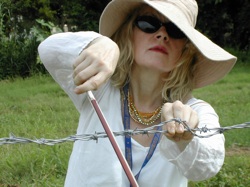 AP: Talking about your own creative work now, how to you envisage the future, from an artist’s perspective? You mentioned that you transcribe the songs you hear. Where do you see this going?
AP: Talking about your own creative work now, how to you envisage the future, from an artist’s perspective? You mentioned that you transcribe the songs you hear. Where do you see this going?
When I did my PhD, I wrote a whole portfolio of compositions based on their songs: two string quartets, a piece for solo bassoon, one for solo bass, bass plus violin and also one for flute. Since then, most of what I have been writing has been for solo violin plus field recordings.
“Cumberdeen dam toccata” (sample), Joanne Cannon on bassoon playing Hollis Taylor’s Composition
The reason I perform with the field recordings is because solo birdsongs tend to be one second followed by about two seconds of silence, followed by another phrase and two seconds of silence and in those silent periods, a human audience can get very uncomfortable, you know, and so… I think the silence is musically valid, but people just aren’t used to silence. So, I thought it would be fun to have field recordings.
These recordings are almost never of Pied Butcherbirds but instead other sounds: I have an auctioneer selling cattle, I do insects, people… I have one called Trailer Park Trash, which is about people at campgrounds saying stupid things or funny things that I play along with. I have all sorts of pieces. Some are more serious, some are more funny, some are more ‘soft environmental messages’ or whatever people want to take away from them. That is the bulk of what I’ve done in the last three years.
Hollis Taylor – violin performance of the piece “Saleyards” is a live performance of transcriptions of three different pied butcherbirds:
Now, I have a commission to write something for The Song Company, which is a group of six vocalists. This is going to be a new way to think about Pied Butcherbird vocalisations. And certainly Pied Butcherbirds take advantage of the aural landscape: they are aural architects. So, I will want to consider how to position the different singers and how to take advantage of these birds’ enthusiasm for the ‘snap-together beads’ approach to musical composition.
AP: Beside the scientific interest of your work, what do you want to do? Where are you going on your creative journey? Do you have a vision? Is it to educate, to illustrate, to entertain?
Well, I think it all works together. I wouldn’t want to just educate if I didn’t think it was entertaining too. I think that when you are onstage, you have to sell, and Pied Butcherbirds understand that as well. This is a highly sophisticated species. I don’t think of this so much as ‘my vision’ of it; I think of being in service to their vision of how their music works.
SO IN CONCLUSION, WHY THE LANDSCAPE?
The principle theme of everything that I am doing involves ‘animal aesthetics’–but don’t get me wrong. For some, a bird is a bit of landscape on the wing. It perhaps seems obvious to believe that birdsong is natural and human music is cultural. However, songbirds learn their songs. Very few species learn their vocalisations–humans are the only primate to do so.
There is a sense that humans are special and only humans have art of whatever kind, a conception that ‘natural’ objects have to then be improved by an artist or a human in order to be ‘Art’. A key aspect of my work is to get us thinking of – as a continuum; it’s not nature/culture. My intent is to uncover and underline the compelling aspects of places where I have recorded Pied Butcherbirds, and in the process spark new ways to mediate human-nonhuman relationships.
Zoömusicology is the study of music in animal culture. Since the word is not yet a familiar one, I may identify myself as a zoömusicologist, but other times I may say I’m a field musicologist, an ornithologist, or simply a student of birdsong. My friend Dominique Lestel, a French philosopher, says in one of his books: ‘A Cartesian is she who refuses to be surprised by an animal’, and I like that so much… I am constantly surprised. Just as an anthropologist might organize an exhibition of artworks from the people she is studying, my birdsong lecture/concerts have proved to be effective in disseminating my research findings to a broader public. Vibrant aesthetic encounters with Pied Butcherbirds in the concert hall have the potential to reset people’s perception of songbirds and how our practices impact them, as well as to reconfigure our feelings of responsibility towards our lonely blue planet and all those who make their lives here. So, my work begins loops between landscape and concert hall. If for a moment here and there I have the conceit that I have improved upon Pied Butcherbird phrases, I more often have the sense that it is they who have improved me as a musician.
For more information about Hollis’ work and music, see:
http://www.hollistaylor.com
http://www.zoomusicology.com
http://www.flutelyrebird.com
http://australiancomposers.com.au/composers/hollistaylor.html
Radio National Interviews of Hollis:
http://www.abc.net.au/radionational/programs/offtrack/dr-hollis-taylor/4183410
http://www.abc.net.au/radionational/programs/musicshow/hollis-taylor-and-the-pied-butcher-bird/4905376
http://www.abc.net.au/radionational/programs/360/bird-interrupted/5276030
